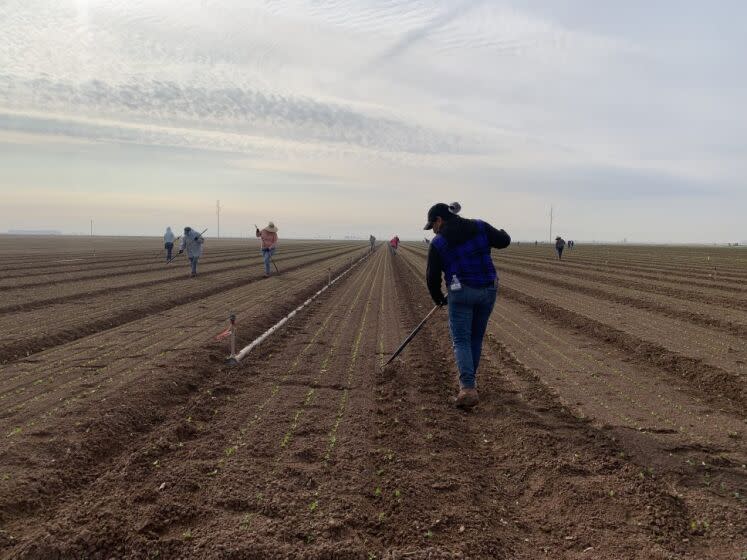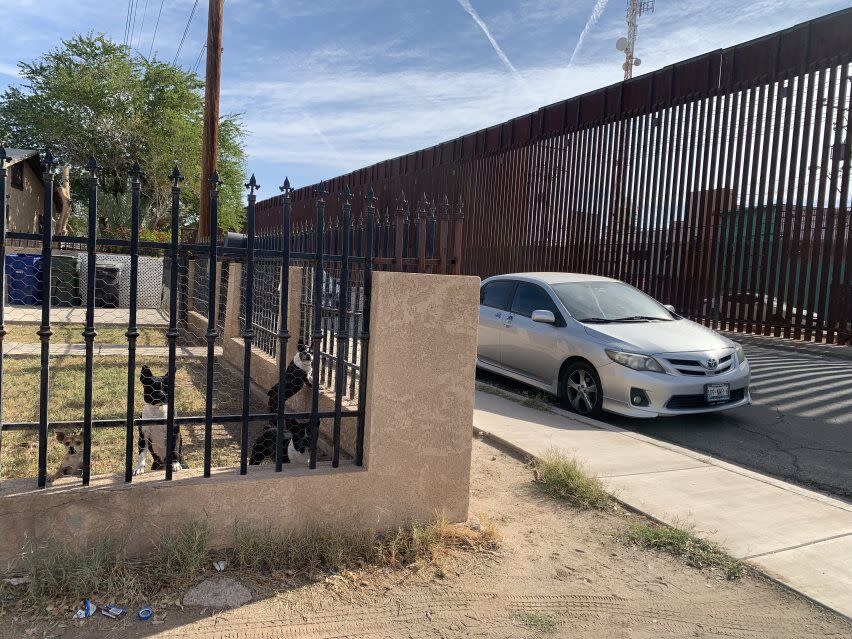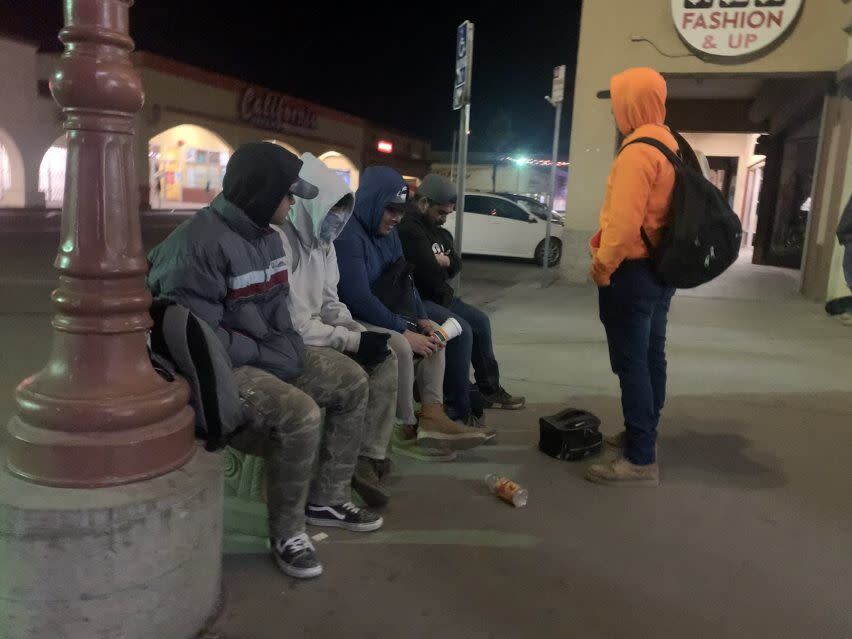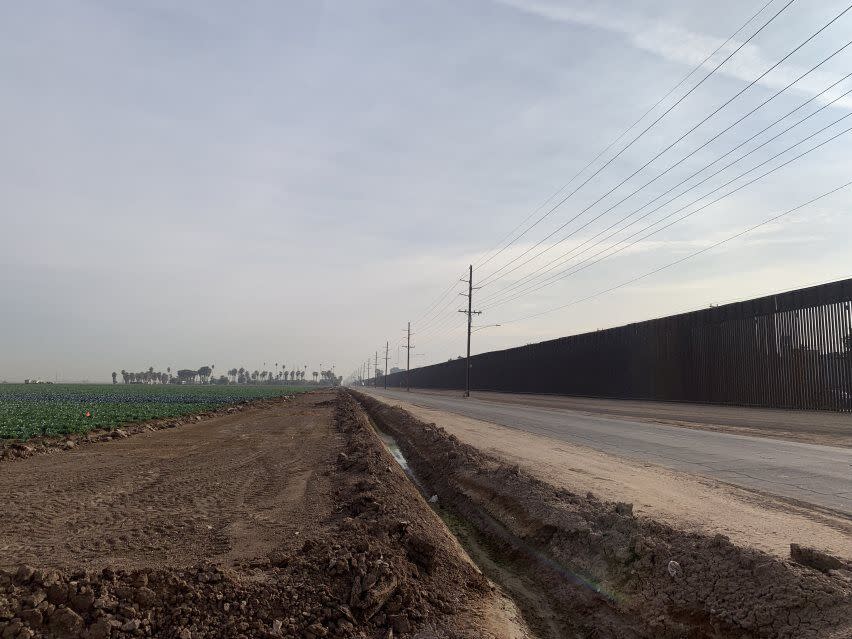Guerrero: If Democrats want to hold Imperial County, they'll have to work for it

- Oops!Something went wrong.Please try again later.
For Democrats who mistake demographics for destiny, Imperial County is a mystery. It’s California’s most heavily Latino county, and yet Republicans have been making gains here.
This isn’t south Texas, where former President Trump’s appeal was rooted in cowboy-idolizing Tejano culture. This is Southern California. The GOP’s allure here is more complicated.
About 200 miles southeast of Los Angeles, the still-blue county does have similarities to the Rio Grande Valley, such as proximity to Mexico and a rural economy. The sprawling fields of the Imperial Valley supply the country with winter vegetables such as lettuce and carrots.
More recently, it has become a leading source of renewable energy with its solar, wind and geothermal production. Imperial County is also the site of a new “gold rush” for lithium, used for electric cars’ batteries.
Voting patterns among the valley’s more than 180,000 residents look like a paradox: trending progressive in some local races while inching toward Republicans in state and national ones. Michael Luellen II, an 18-year-old out gay Latino, won a City Council seat in Calipatria. Raúl Ureña, 25, who is transgender, was reelected to Calexico’s City Council, alongside their ally Gilberto Manzanarez, 29. Countywide leadership is becoming younger and more diverse, reflecting a desire for change.
At the same time, Democrats’ margins of victory for top-of-the-ballot positions, such as governor and attorney general, shrank in the midterm elections last month. The GOP is continuing to make inroads here after Trump won 36% of the county’s vote in 2020, up from 26% four years before. There’s one through-line here: rejection of the status quo.

At the county’s southern end in Calexico, where the border wall’s steel columns and barbed wire cast shadows over farms and houses steps from neighboring Mexicali, common adjectives that people used to describe Trump to me were “loco” and “racista.” Crazy and racist.
In this part of the county, people roll their eyes at Republican rhetoric about “open borders.” Locals see the reality: The region is militarized and has been for years. Border Patrol vehicles are everywhere. Green-clad agents stroll on the sidewalks and eat in the taco shops, guns on their hips. Nearly 50 miles to the north, a Border Patrol checkpoint serves as a second border.
The damage done by that militarization is visible. One resident whose front yard faces the 30-foot-tall wall told me he has seen multiple people fall from it, sometimes breaking bones. In hospitals, the severely dehydrated cling to life after trying to evade Border Patrol agents in the triple-digit heat in the desert. They’re the lucky ones who made it; hundreds of people die trying every year.
The less-visible damage of the closed border, such as split-up families and the suppressed wages of criminalized labor, are deeply felt in the community. By 2:30 a.m. one recent Thursday, the streets near the border were bustling — as they usually are at that hour — with people coming over from Mexico and waiting for rides to work in fields on the U.S. side for about $100 a day. Teenagers, mothers and gray-haired men alike filed into white buses sent by farm companies to collect them.

Most of the county’s farmworkers have green cards, based on my conversations with them and local leaders. But they can’t afford to live in California. So they live south of the border, in Mexicali, and cross daily at the port of entry before sunrise, often commuting hours each way. “It’s grueling work,” said Arnulfo Rivas, a 55-year-old farmworker who lives in Mexicali and crosses daily. “Not just anyone can do it.”
The workers are a diverse group, including educated older Mexicans such as lawyers and engineers, who earn more picking crops than they would pursuing their careers in Mexico. Even U.S. citizens such as Mariciel, a 16-year-old who lives in Mexicali with her mother, work the fields. She told me she’d like to attend high school in Mexicali, but she hasn’t been able to enroll because she doesn’t have Mexican documents.
A closed border can render Americans illegal, too.
This chronically subjugated workforce is the backbone of the county’s $2-billion agriculture industry. I spoke with a dozen workers on a recent visit to Imperial County, and none votes. Either they can’t because they’re not citizens or they’re under 18, or they don’t because they don’t see the point. They don’t believe politicians care about them.
Imperial County, which is 85% Latino, has the state’s lowest turnout of registered voters, attributable to decades of disenfranchisement and dismal outreach. Officials have failed to provide important election materials and other documents in Spanish, spoken by most residents. “For years we’ve had endless corruption and bad decisions made, but all of these decisions were always made in English,” Ureña, the Calexico City Council member, told me.
The American Civil Liberties Union is pressuring the county to correct its course, and Calexico is working to make documents available in both English and Spanish.
Some Republicans have done a better job engaging residents of Imperial County than their Democratic counterparts have. The last governor to visit was Arnold Schwarzenegger, a Republican. Trump stopped by for a Calexico photo op in 2019.
No wonder the county inched closer to Trump, a trend led by residents farther north, such as in El Centro. Catholic churches there advertised against this year’s abortion rights measure, Proposition 1, and urged members to pray for an end to abortion. One Mexican American woman resident told me her antiabortion views led her to stop identifying as a Democrat in 2016 and to instead vote exclusively for Republicans.
But for most of the people I interviewed in El Centro, abortion was not as big of an issue as immigration, which animates the minority white residents, including one of the first white men I met in this city. “We need to close the borders and hunt down all the illegals and get them the hell out of this country,” he told me, declining to give his name.
Others had a more sympathetic tone. Paul Kirby, 67, a retired kitchen equipment salesman, said of undocumented immigrants: “I’m not saying they don’t have a right to be here. They just don’t have a right to do it the way they’re doing.” He prefers Florida’s Gov. Ron DeSantis over Trump, who is “up there in age” and has distracting legal troubles.
Riding his ATV near the border for fun recently, Kirby was relieved to see construction on the border wall continuing under President Biden, contrary to “open borders” hysteria he had been hearing on Fox News.
Imperial County also has its MAGA Latinos. Manuel, 46, is a Latino delivery truck driver shaped by right-wing disinformation. He declined to give his last name for fear of political persecution. “They’re coming after everybody who supports Trump,” he told me.
Manuel opposes the COVID-19 vaccines and gets his “news” from podcasts such as “The Charlie Kirk Show,” “The Dan Bongino Show” and “The Tim Pool Daily Show” while he’s driving for work. He never voted until Trump came along promising to “drain the swamp.”
He explained: “I wasn’t into politics back then. I had the whole Latino attitude view [that] my vote didn’t count. But it does count now.”
Manuel said he wasn’t bothered by Trump’s tax troubles, or bragging about sexual assault, or by anything else Trump did. In his view, Democrats were going after Trump for “regular stuff, dumb stuff.”
In Manuel’s opinion, everything was better when Trump was president. “Now,” he said, “the country is ran by Biden, his son, all that stuff going on, that’s not good, the laptop, the child pornography.”
Manuel’s fact-free worldview is representative of a growing minority of Latinos, particularly men, who are drawn to the demagogue.
But I also encountered no-longer-MAGA Latinos in Imperial County, including Sam, a 60-year-old retired Border Patrol agent whose mother is from Mexico. He was preparing to adjust his Christmas lights when I approached him. Sam agreed to speak on the condition that I not use his last name because he’s still friends with many Border Patrol colleagues, who might be appalled if they learned of his antipathy toward Trump.
“We thought he was the next messiah,” he told me. “I realize now that it was all about him, not the American people.”
He voted for Trump twice, but Sam told me he’d never do that again.

Like many Latinos in law enforcement, Sam wasn’t a Republican until he began training and immersed himself in his employer’s culture.
He still agrees with Republicans on halting immigration. But he began to sour on Trump while the reality TV star was in office, suggesting injections of disinfectant to treat COVID and asking for money via shameless campaign text messages. “It seemed like a scam,” Sam said.
He voted for Trump in 2020 only because of his positions on the border, but since then the Jan. 6 attack on the Capitol and allegations of Trump’s mishandling of classified documents have permanently alienated Sam.
This change of heart reflects a larger disenchantment among voters with traditional law-and-order values, who’ve come to see Trump as lawless. Democrats can reverse GOP inroads with voters like Sam by contrasting themselves with Trump’s crookedness and the GOP’s coddling of him.
But talking points aren’t enough. Democrats in power must invest in better education and jobs in the Imperial Valley. Right now, low-income Latinos there have few paths to the middle class besides working for the Border Patrol, which encourages Trumpism.
Residents who want a higher education often leave to pursue it. The county has the state’s highest rates of unemployment and childhood hunger. About 40% of its children don’t eat enough.
Ureña, of the Calexico council, wanted to help their community, returning after obtaining a bachelor’s in economics at UC Santa Cruz. Although they used to find themself thinking, “I don’t matter to the state of California,” they imagined themself as a nopal, a prickly pear used as a synonym for Mexico, saying: “I’m Mexican. Soy un nopal. I’m a cactus. I know how to grow in harsh environments.”
Ureña and City Manager Esperanza Colio Warren, the first Mexican American woman in her position, accompanied me to the border four hours before sunrise on a recent Thursday. They wanted me to see the sacrifices so many Mexicans make simply to work, harvesting food for Americans to eat. “We live off of them,” Colio Warren said.
Meanwhile, tens of thousands of more privileged Mexicans with dual citizenship or residency drive across the border daily for office jobs, private schools or luxury shopping here. Americans cross into Mexico for affordable dental services and healthcare. For the white or well-off, the border has always been permeable. The movement of everyone else is policed, creating a precarious workforce for the wealthy.
Trumpism is incompatible with the needs of this mixed-status community and will fizzle here. But Democrats’ one-way relationship with Imperial County, which feeds and powers cities, is also unsustainable. State and federal leaders who win this county’s support must learn to give back, not only with resources but also by shifting the conversation about the border. When Trump visited the valley in 2019, he declared the country "full." Democrats must visit and tell a different story — one rooted in the reality of residents.
Otherwise, they shouldn’t be surprised if another Republican candidate in the future wins a following here, or if many more residents turn their back on voting altogether. Then the Latino vote would remain elusive.
This story originally appeared in Los Angeles Times.
